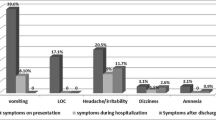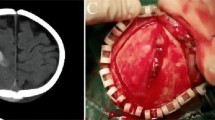Abstract
Background
To determine whether skull fractures can be used to associate intracranial hemorrhage with minor head trauma (MHT).
Objective
We conducted a retrospective study evaluating the association between linear skull fractures and intracranial hemorrhage among children with MHT. Furthermore, we evaluated the significance of small intracranial hemorrhages by assessing the need for neurosurgical interventions.
Materials and methods
The case group included 114 children with a diagnosis of a linear skull fracture and the control group included 125 children without the diagnosis. We conducted multivariable logistic regression analyses to estimate the odds ratio (OR) between linear skull fractures and intracranial bleeding.
Results
Among the cases, 29 of 114 (25%) children were diagnosed with an intracranial hemorrhage on CT, compared to only 14 of 125 (11%) among the controls. The multivariable OR for intracranial hemorrhages comparing cases and controls adjusted for age and gender was 2.17 (95% confidence interval [CI]: 1.01, 4.68). All the intracranial hemorrhages were small (3.8 ± 2.3 mm) and none of them required any neurosurgical intervention.
Conclusion
The presence of a linear skull fracture is an independent risk factor for intracranial hemorrhage. However, all the intracranial hemorrhages associated with the skull fractures were small and did not require any neurosurgical interventions.



Similar content being viewed by others
References
Blackwell CD, Gorelick M, Holmes JF et al (2007) Pediatric head trauma: changes in use of computed tomography in emergency departments in the United States over time. Ann Emerg Med 49:320–324
Brenner DJ, Hall EJ (2007) Computed tomography—an increasing source of radiation exposure. N Engl J Med 357:2277–2284
Rice H, Frush D, Farmer D et al (2007) Review of radiation risks from computed tomography: essentials for the pediatric surgeon. J Pediatr Surg 42:603–607
Campbell KA, Berger RP, Ettaro L et al (2007) Cost-effectiveness of head computed tomography in infants with possible inflicted traumatic brain injury. Pediatrics 120:295–304
Durham SR, Liu KC, Selden NR (2006) Utility of serial computed tomography imaging in pediatric patients with head trauma. J Neurosurg 105:365–369
Shireen M, Atabaki MD, Stiell IG et al (2008) A clinical decision rule for cranial computed tomography in minor pediatric head trauma. Arch Pediatr Adolesc Med 162:439–445
Holmes JF, Vance CW, Gelber RE et al (2003) A decision rule for identifying children at low risk for brain injuries after blunt head trauma. Ann Emerg Med 42:492–506
Mower WR, Hoffman JR, Herbert M et al (2005) Developing a decision instrument to guide computed tomographic imaging of blunt head injury patients. J Trauma 59:954–959
Hofman PA, Nelemans P, Kemerink GJ et al (2000) Value of radiological diagnosis of skull fracture in the management of mild head injury: meta-analysis. J Neurol Neurosurg Psychiatry 68:416–422
Carty H, Patterson M, Butcher CK et al (1997) Predictive value of skull radiography for intracranial injury in children with blunt head. Lancet 349:821–824
Letourneau P, Vitorino E, McCall J (2001) Pediatric minor head trauma: indications for computed tomographic scanning revisited. J Trauma 51:231–237
Qualle KS, Jaffe DM, Kuppermann N et al (1997) Diagnostic testing for acute head injury in children: when are head computed tomography and skull radiographs indicated. Pediatrics 99:E11
Holsti M, Kadish HA, Sill BL et al (2005) Pediatric closed head injuries treated in an observation unit. Pediatr Emerg Care 21:639–644
Golden N, Maliawan S (2005) Clinical analysis of non-accidental head injury in infants. J Clin Neurosci 12:235–239
Jagoda AS, Cantrill SV, Wears RL et al (2002) Clinical policy: neuroimaging and decision making in adult mild traumatic brain injury in the acute setting. Ann Emerg Med 40:231–249
Oman JA, Cooper RJ, Holmes JF et al (2006) Performance of a decision rule to predict need for computed tomography among children with blunt head trauma. Pediatrics 117:e238–246
Saboori M, Ahmadi J, Farajzadegan Z (2007) Indications for brain CT scan in patients with minor head injury. Clin Neurol Neurosurg 109:399–405
Greenes DS, Schutzman SA (1999) Clinical indicators of intracranial injury in head-injured infants. Pediatrics 104(4 Pt 1):861–867
Mogbo KI, Slovis TL, Canady AI et al (1998) Appropriate imaging in children with skull fractures and suspicion of abuse. Radiology 208:521–524
Andronikou S, Kilborn T, Patel M et al (2003) Skull fracture as a herald of intracranial abnormality in children with mild head injury: is there a role for skull radiographs? Australas Radiol 47:381–385
Bonadio WA, Smith DS, Hillman S (1989) Clinical indicators of intracranial lesion on computed tomographic scan in children with parietal skull fracture. Am J Dis Child 143:194–196
De Souza M, Moncure M, Lansford T et al (2007) Nonoperative management of epidural hematomas and subdural hematomas: is it safe in lesions measuring one centimeter or less? J Trauma 63:370–372
Brenner D, Elliston C, Hall E et al (2001) Estimated risks of radiation-induced fatal cancer from pediatric CT. AJR 176:289–296
Author information
Authors and Affiliations
Corresponding author
Rights and permissions
About this article
Cite this article
Erlichman, D.B., Blumfield, E., Rajpathak, S. et al. Association between linear skull fractures and intracranial hemorrhage in children with minor head trauma. Pediatr Radiol 40, 1375–1379 (2010). https://doi.org/10.1007/s00247-010-1555-4
Received:
Revised:
Accepted:
Published:
Issue Date:
DOI: https://doi.org/10.1007/s00247-010-1555-4




